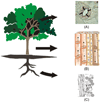Nanoparticles in the environment: assessment using the causal diagram approach
- PMID: 22759495
- PMCID: PMC3388445
- DOI: 10.1186/1476-069X-11-S1-S13
Nanoparticles in the environment: assessment using the causal diagram approach
Abstract
Nanoparticles (NPs) cause concern for health and safety as their impact on the environment and humans is not known. Relatively few studies have investigated the toxicological and environmental effects of exposure to naturally occurring NPs (NNPs) and man-made or engineered NPs (ENPs) that are known to have a wide variety of effects once taken up into an organism. A review of recent knowledge (between 2000-2010) on NP sources, and their behaviour, exposure and effects on the environment and humans was performed. An integrated approach was used to comprise available scientific information within an interdisciplinary logical framework, to identify knowledge gaps and to describe environment and health linkages for NNPs and ENPs. The causal diagram has been developed as a method to handle the complexity of issues on NP safety, from their exposure to the effects on the environment and health. It gives an overview of available scientific information starting with common sources of NPs and their interactions with various environmental processes that may pose threats to both human health and the environment. Effects of NNPs on dust cloud formation and decrease in sunlight intensity were found to be important environmental changes with direct and indirect implication in various human health problems. NNPs and ENPs exposure and their accumulation in biological matrices such as microbiota, plants and humans may result in various adverse effects. The impact of some NPs on human health by ROS generation was found to be one of the major causes to develop various diseases. A proposed cause-effects diagram for NPs is designed considering both NNPs and ENPs. It represents a valuable information package and user-friendly tool for various stakeholders including students, researchers and policy makers, to better understand and communicate on issues related to NPs.
Figures








References
-
- Powell MC, Kanarek MS. Nanomaterial health effects--part 1: background and current knowledge. Wisc Med J. 2006;105:16–20. http://www.wisconsinmedicalsociety.org/_WMS/publications/wmj/pdf/105/2/1... - PubMed
Publication types
MeSH terms
LinkOut - more resources
Full Text Sources
Miscellaneous

